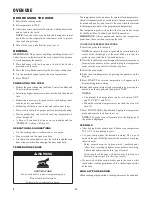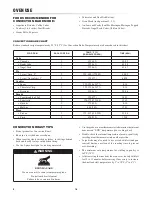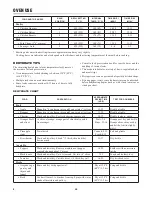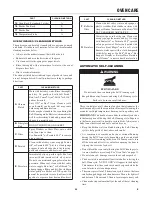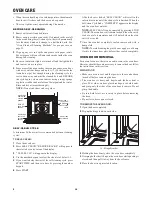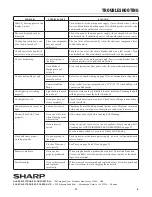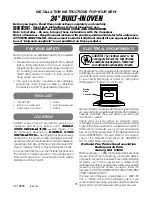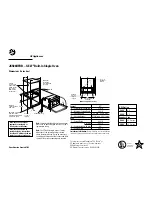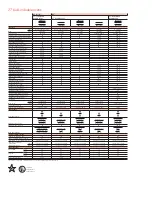
E
13
OVEN USE
OVEN RACKS
IMPORTANT: To avoid permanent damage to the porcelain
finish, place food or bakeware on an oven rack. Do not place
food or bakeware directly onto the oven door or oven bottom.
• The oven racks can be placed in any of the six height positions
with the oven.
• Position racks before turning on the oven.
• Make sure the oven racks are level.
• Oven racks have a stop to keep them from being unintention-
ally withdrawn fully.
TO REMOVE OVEN RACKS:
• Pull rack out to the stop position, raise the front edge, and
then lift out.
TO REPLACE OVEN RACKS:
• Place oven rack on the wire supports along the sides of the
oven. Tilt the front edge up slightly, and slide rack to the rear
until it clears the stop position. Lower the front and slide the
rack into the oven.
COMPONENT COOLING FAN
Activates during any cooking or self-cleaning mode to cool
inner components and outer door surfaces. This air is exhausted
through the vent located above the oven door. It continues to
run until components have cooled sufficiently. The cooling fan
operates at double speed (or RPM’s) in self-clean and whenever
the internal components temperature becomes high.
OVEN DOOR
To avoid oven door glass breakage:
• Do not close the oven door if the racks are not fully inserted
into the oven cavity or if bakeware extends past the front
edge of an oven rack.
• Do not set objects on the glass surface of the oven door.
• Do not hit glass surfaces with bakeware or other objects.
• Do not wipe down glass surfaces until the oven has completely
cooled.
OVEN VENTS
Blocking or covering the oven vents will cause poor air circula-
tion, affecting cooking, cleaning and cooling results.
• Both the upper and lower oven vent(s) allow fresh air to enter
the cooling system.
• The lower oven vent also allows hot air to be expelled from
the cooling system.
OVEN CONDENSATION AND TEMPERATURE
• It is normal for a certain amount of moisture to evaporate from
the food during any cooking process. The amount depends
on the moisture content of the food.
• The moisture may condense on any surface cooler than the
inside of the oven, such as the control panel.
• Your new oven has an electronic temperature sensor to help
maintain an accurate temperature. Your previous oven may
have had a mechanical thermostat that drifted gradually over
time to a higher temperature. It is normal that you may need
to adjust your favorite recipes when cooking in a new oven.
OVEN TEMPERATURE CONTROL
The oven provides accurate temperatures; however, it may cook
faster or slower than your previous oven, so the temperature
calibration can be adjusted. It can be adjusted in degrees
Fahrenheit or Celsius.
A minus sign means the oven will be cooler by the displayed
amount. The absence of a minus sign means the oven will be
warmer by the displayed amount.
Use the following chart as a guide:
ADJUSTMENT °F
(ADJUSTMENT °C)
COOKS FOOD
10°F (6°C)
a little more
20°F (12°C)
moderately more
30°F (17°C)
much more
-10°F (-6°C)
a little less
-20°F (-12°C)
moderately less
-30°F (-17°C)
much less
TO ADJUST OVEN TEMPERATURE CALIBRATION:
1
Press SETTINGS. The various Options will appear in the
display.
2
Press number 9 on the keypad. “CALIBRATION” “PRESS
3 TO INCREASE/PRESS 6 TO DECREASE” will scroll
across the display.
3
Press number 3 on the keypad to increase or number 6 to
decrease the temperature in 5°F (3°C) increments. The
adjustment can be set between 30°F (18°C) and -30°F (-18°C).
4
Press SETTINGS to save the adjustment, and then exit the
Temperature Calibration menu.
OVEN MODES
The illustrations show the heating elements and fans used for
each oven mode.
NOTE: The lower element is concealed under the oven floor.
BAKE
Baking is cooking with heated air. Both upper and lower ele-
ments in the oven are used to heat the air but no fan is used to
circulate the heat.
Summary of Contents for SWA3052DS
Page 28: ......
Page 58: ......
Page 59: ......
Page 60: ...Sharp Électronique du Canada Ltée 335 rue Britannia Est Mississauga Ontario L4Z 1W9 Canada ...












